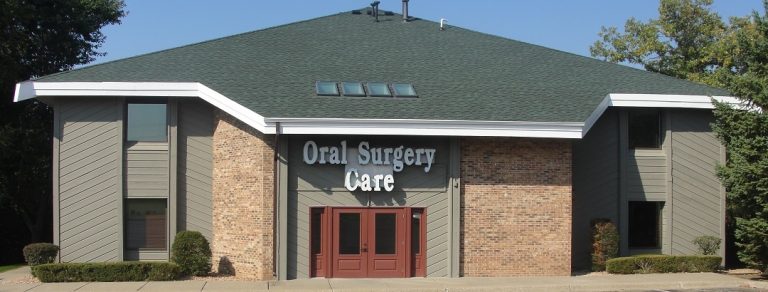
Hours:
Monday – Friday
8:00 a.m. to 5:00 p.m.
Phone:
(651) 688-8592
Frequently Asked Questions:
Frequently Asked Questions
Wisdom Teeth
Why are they called Wisdom Teeth?
The last teeth to develop and erupt into the jaws are called the third molars. Third molars usually erupt in the late teen years, which coincides with passage into adulthood and is referred to by some as the age of wisdom; hence “wisdom teeth”. Unfortunately, the wisdom teeth are now usually trying to erupt into a jaw that is too small.
What is the purpose of Wisdom Teeth?
Wisdom teeth used to serve a useful purpose, but are now considered vestigial organs. A vestige is a degenerative or imperfectly formed organ or structure having little or no utility, but in the earlier stage of development of a species performed a useful function. The reasons that wisdom teeth are now “outdated” are many. Until quite recently, our diet included mostly very coarse food, as well as impurities such as dirt and sand. This coarseness would abrade teeth so significantly that they would take up less space in the jaw. Permanent teeth were also frequently lost at an early age, which would create more space in the jaw. Because the diet was so coarse and hard to chew, the jaw itself would develop into a larger bone because of this constant workout. All of these factors would create more space for the wisdom teeth when they came in.
The heavily processed diet of today does not produce the tooth abrasion or jaw development that we used to see. Modern dentistry has pretty much eliminated significant loss of permanent teeth at an early age. This leaves us with too many teeth and not enough jaw. The wisdom teeth still develop as they always have, but they have no where to go. When this happens, the teeth are considered “impacted,” meaning that they are not in normal position and function.
What are impacted Wisdom Teeth?
Besides serving no useful function, the impacted teeth will often cause damage because they cannot be cleaned properly and can collect food debris, bacteria and plaque around them. This can result in tooth decay, gum disease, infection and abscess of not only the wisdom teeth, but of the molars next door and of the surrounding gum tissue. The molars in front of the wisdom teeth are sometimes lost because of cavities and gum disease caused by the inability to clean the wisdom teeth properly. Cyst formation and other destructive pathology are also seen around impacted wisdom teeth.
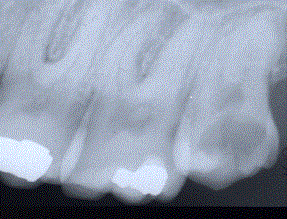
Third Molar Caries
Soft tissue inflammation, pain and infection often result from this inability to clean third molars. Pericoronitis, buccal and submandibular space infections can also result, which will sometimes cross the midline to cause a life-threatening Ludwig’s angina.
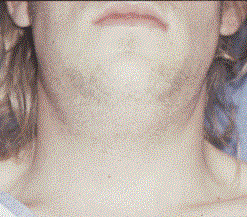
Ludwig's Angina
Third molars can also contribute to caries or periodontal disease of the second molars, and occasionally cause these teeth to be lost.
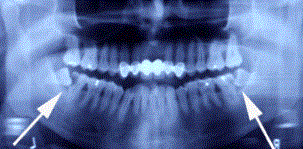
Second Molar Caries
Cysts and tumors can also develop around third molars, which can cause migration of the teeth and massive destruction of bone. These are usually benign odontogenic cysts, such as dentigerous cysts or odontogenic keratocysts, but much more aggressive tumors such as ameloblastomas are occasionally seen.
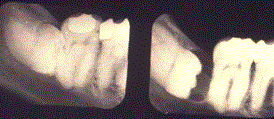
This example shows the development of a dentigerous cyst in a 45 year-old female over a three-year period.
Dentigerous Cyst Development
This series of radiographs shows the development of a dentigerous cyst over a ten-year period. Note that the third molar was migrating distally, out of range of the bitewing films. A secondary infection of the cyst caused symptoms that led to a periapical film and panorex of the area in question. This illustrates the destructive nature of benign cysts.
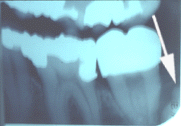
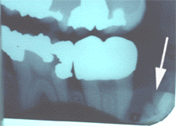
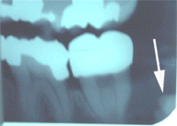
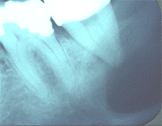
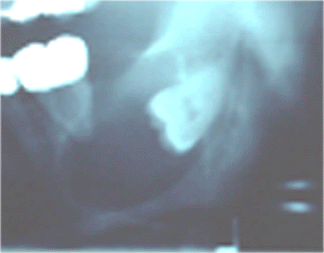
Third molars can sometimes contribute to mandibular fractures because their sockets can serve as the start of a fracture plane.
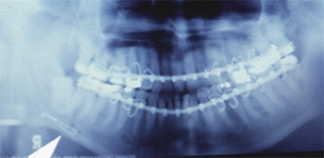
Mandibular Fracture Through Third Molar Socket
Complications associated with the removal of impacted teeth usually increase with age. Younger patients are generally better able to tolerate surgical procedures. Inferior alveolar nerve damage is less likely when the roots of the third molars are not completely formed.
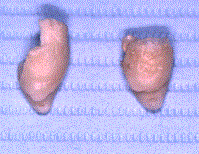
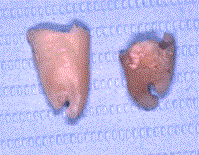
Third molar root development around inferior alveolar nerve
